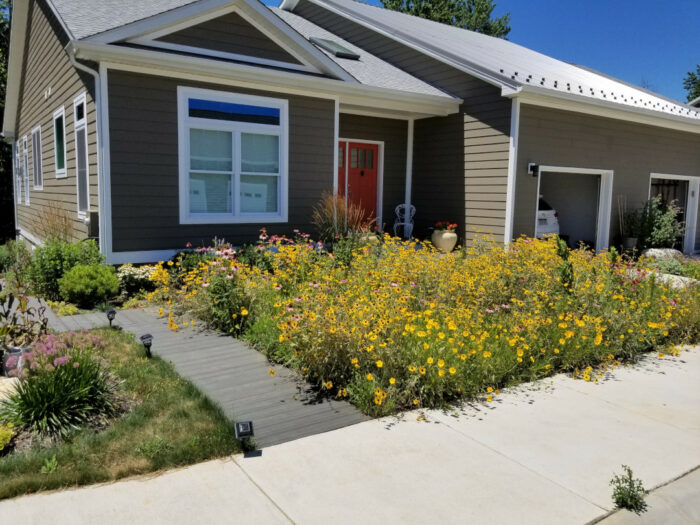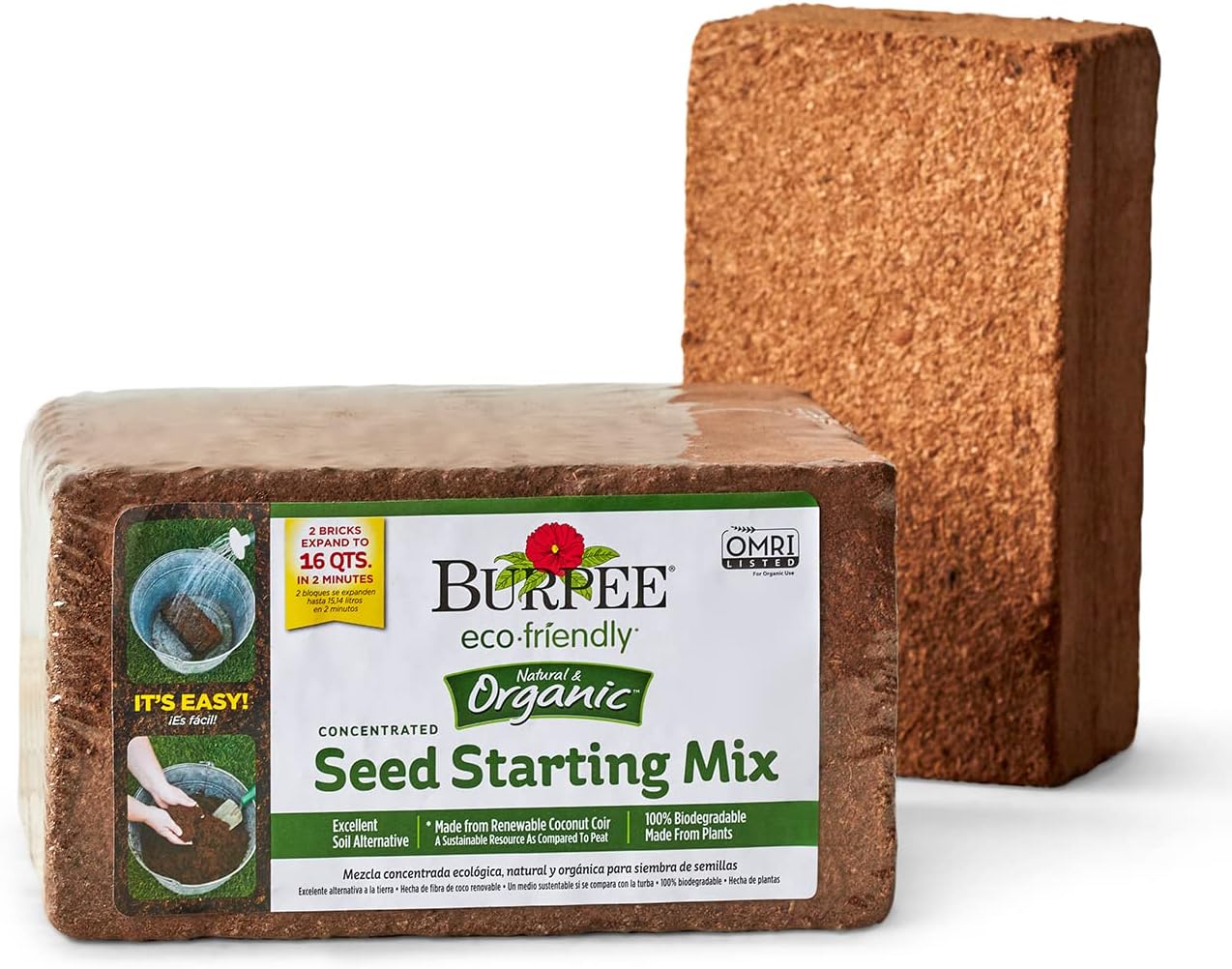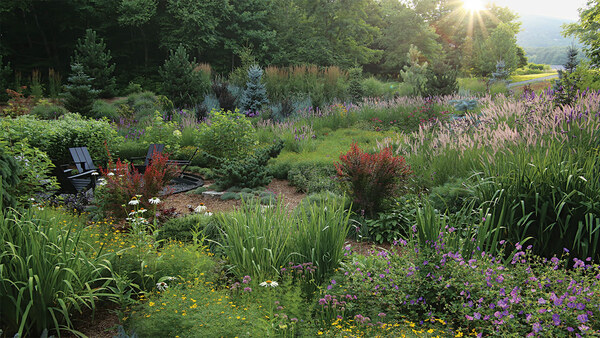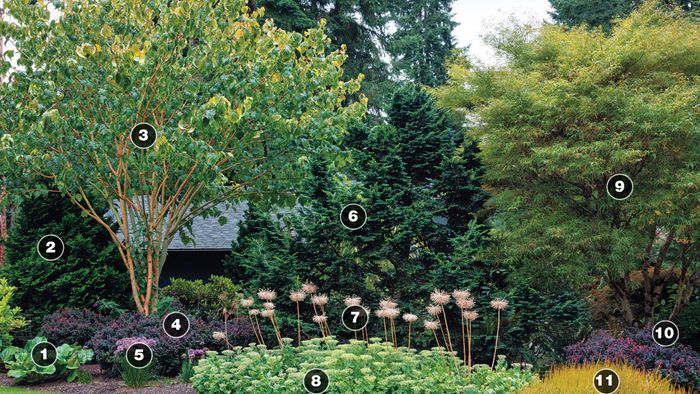Today’s photos are from James Dillon.
I own a small landscaping/gardening company located near Harpers Ferry, West Virginia. We specialize in residential landscape design/installation and small-scale ecologically valuable plantings like meadows, rain gardens, pollinator gardens, etc. Below are photos I took over a three-year period (part of four growing seasons) of a pocket meadow we planted from seed in 2019.
Here’s the site on June 25, 2019, before sowing the meadow seed. We delayed seeding until the end of June to give us more time to prepare the site. The first key to success was making sure that there wasn’t any existing vegetation or weeds (cool-season weeds OR warm-season weeds) and that the soil seed bank was depleted of invasive plants.
This is from October 29, 2019, just four months after seeding. The newly seeded meadow was watered a couple times per week during this first summer to speed up germination. The yellow flowers are Rudbeckia hirta (Zones 3–8). Weeds that were coming in were addressed before they could get established, clone themselves, or set seed.
One year after seeding: Rudbeckia hirta is blooming heavily, a butterfly weed flower (Asclepias tuberosa, Zones 3–9) is already visible, a few purple coneflowers (Echinacea purpurea, Zones 3–8) are mature enough to flower, and the Coreopsis lanceolata (Zones 4–9) came up extremely well from seed and will be next to flower.
One month after the previous photo, the Coreopsis lanceolata chimed in to make a solid cover of yellow flowers. A few more Echinacea purpurea started to flower as well.
Three weeks later, we cut back the Rudbeckia hirta and Coreopsis lanceolata to allow more direct sunlight down to the slower, longer-lived perennials like butterfly weed, smooth aster (Symphyotrichum laeve, Zones 4–8), and stiff goldenrod (Solidago rigida, Zones 3–9). Lavender hyssop (Agastache foeniculum, Zones 2–6) is starting to make an appearance. Allium ‘Millenium’ (Zones 5–8) blossoms in the foreground, and a small area of “Low-Mow” grass is starting to grow in.
Two years after seeding, the meadow is filling in with various flowers, including wild quinine (Parthenium integriolium, Zones 4–8), lavender hyssop, purple coneflower, and butterfly weed. Annual fleabane (Erigeron annuus) is a welcome addition at this time, since the meadow is quite far along in its establishment and most holes are already filled. In earlier stages, the annual fleabane could become a weed. The larger, glaucous leaves and bold upright habit of stiff goldenrod are providing contrast even before its flowers open.
Monarch butterfly on lavender hyssop
During the fourth growing season, three years after sowing the meadow, we’re not seeing Coreopsis lanceolata anymore, and Rudbeckia hirta has also largely yielded to allow other native perennials to fill the area. We’re seeing lots more butterfly weed, purple coneflower, and wild quinine. We wanted to keep the meadow a bit shorter this year, so we cut everything back to 10 inches in midspring. This photo shows the regrowth seven weeks after that cut. Plants recovered totally fine and have grown back shorter and more full. We’re finally seeing some little bluestem grass (Schizachyrium scoparium, Zones 3–9) and more asters and goldenrod. Those late-blooming perennials will ensure that pollinators have forage for the rest of the season, until frost.
Since the meadow is largely established, we allow some of the annual fleabane (a native) to come in on its own, because it provides the frothy white blooms in the summer. In the fall, I rely on calico aster (Symphyotrichum lateriflorum,
Zones 4–8) for a similar effect.
I hope you’ve enjoyed the history and photos of this little pocket meadow. I’m hoping this demonstrates that a “meadow” doesn’t need to be any particular size. A small site is best to start with anyway because it can be managed to become a stable plant community, requiring less weeding/monitoring over time, which may just free up some time to start the next area. Each year brings distinct changes in the seeded meadow, so the seed mix needs to be designed with the short and long term in mind. The reason this project had such a smooth, fast trajectory is because the site had virtually no competition from existing weeds, or those coming from the soil seed bank. Monitoring was frequent, and work was done early on to address weeds before they could multiply.
For more information on James and his design work, check out his website: nativehavens.com
Have a garden you’d like to share?
Have photos to share? We’d love to see your garden, a particular collection of plants you love, or a wonderful garden you had the chance to visit!
To submit, send 5-10 photos to gpod@taunton.com along with some information about the plants in the pictures and where you took the photos. We’d love to hear where you are located, how long you’ve been gardening, successes you are proud of, failures you learned from, hopes for the future, favorite plants, or funny stories from your garden.
Have a mobile phone? Tag your photos on Facebook, Instagram or Twitter with #FineGardening!
Do you receive the GPOD by email yet? Sign up here.
Fine Gardening Recommended Products
Johnny’s Selected Seeds Connecta® Cultivation Kit
Fine Gardening receives a commission for items purchased through links on this site, including Amazon Associates and other affiliate advertising programs.
Choose the right tool head for the job and switch out quickly with a simple push-button release. Includes the Connecta receiver, Connecta Collinear 4 head, Connecta Collinear 7 head, Connecta Contour Wire 4 head, Connecta Contour Wire 6 head, a sustainably harvested oiled ashwood handle, and a stainless-steel carrying clip.
Ho-Mi Digger - Korean Triangle Blade
Fine Gardening receives a commission for items purchased through links on this site, including Amazon Associates and other affiliate advertising programs.
Versatile Tool: The Easy Digger Korean Triangle Blade Ho Mi Ho-mi is a versatile gardening tool designed for leveling and digging in home and garden settings. Efficient Design: Its unique triangular blade shape allows for easy soil penetration and efficient leveling of garden beds or landscaping areas. Durable Construction: Crafted with sturdy materials, this tool ensures long-lasting performance and reliability.
Ergonomic Handle: The comfortable handle provides a secure grip, reducing hand fatigue during extended use. Compact Size: Its compact design makes it easy to maneuver in tight spaces and store when not in use.
Burpee Organic Coconut Coir Concentrated Seed Starting Mix, 16 Quart
Fine Gardening receives a commission for items purchased through links on this site, including Amazon Associates and other affiliate advertising programs.
ORGANIC COCONUT COIR: Made from recycled coconut husks, coir is a light, sustainable growing medium that holds the perfect amount of moisture for starting seeds. 100% biodegradable soil alternative. Environmentally friendly and a renewable alternative to peat moss. OMRI listed and certified organic. IDEAL GROWING MIX: Improve seed germination and root growth with this premium coconut fiber mix, which improves nutrients absorption! Great for flower, vegetable, herb, and more plant types. OMRI listed. Naturally disease and pathogen resistant, it will help you grow healthy live plants. EASY TO STORE & EXPAND: Each compact coconut coir brick expands into 8 quarts of seed starting mix, providing 16 quarts total. Just add water to expand! Dehydrated bricks save space until planting. Once expanded, coconut coir provides a quality growing medium for all types of plants—indoor plants, house plants, outdoor plants, and more! NATURALLY CONSERVES WATER: Renewable coco coir has excellent moisture retention and better air circulation than peat. This eco-friendly, premium seeds starting mix combines well with other potting soil and compost for container plants & raised beds. 100% GUARANTEED: Burpee is committed to the success of all gardeners. We treat each order with care to ensure healthy seeds, plants, soil mixes, and gardening supplies are sent in excellent condition. If you are unsatisfied with your purchase, we aim to make it right!































Comments
Awesome! Thanks for sharing.
Thank you! Sure thing!
Great to see what it takes to create a native plant area. Good Job.
So glad to hear that, thank you! I'm planning to keep up the monitoring (5 minutes every 2 weeks) to make sure Bindweed and Crown Vetch don't get established.
I love this - great job!! So pretty!!
I'm surprised that some of the more conventional lawn-loving neighbours haven't complained though....and I hope they don't.
I can't figure out what those bumpy things are on top of the garage.
Thank you! Luckily, so far so good with the neighbors, but it's a unique neighborhood with lots of like minded people (go pollinator people!). Those bumps on the roof are for breaking up snow/ice so it doesn't flatten what's below.
I agree: "Go pollinator people!" How interesting about the bumps on the roof being for breaking up snow/ice so it doesn't flatten what's below. Very interesting. Learn something new every day.
I'm so impressed! All from seeds...I never have any luck with most seeds. It was fun to read how your meadow garden changed over the months and how you cut it back at times (I've heard that called "The Chelsea chop" and I've tried it with some super tall asters and it works well!) So interesting how some plants faded away and others took over...and it all ended up looking beautiful through all the various stages!
Thank you so much! Yes, all seeds : ) We followed the things we learned at NDAL (New Directions in the American Landscape). For the seeds to sprout, we had absolutely perfect conditions: ZERO competition from existing vegetation or weeds was absolutely key. Loose soil (without deep tilling), and area small enough to use watering to push germination and erase drought stress the first season. More weeding....YES, the Chelsea chop! It's such a useful tool for managing height, bloom time and floppiness! Really appreciate your thoughtful comment : )
What a lovely meadow. All the beneficial pollinators must be so grateful for what you have achieved. And it is so very pretty. Congratulations.
Thank you, really appreciate that! It's really amazing to stand there on the sidewalk and watch the pollinators. I was climbing in there today to go after some Bindweed and Crown Vetch, and saw a Monarch larvae on the Butterfly Weed : )
Crazy, delightful!!!
Thank you, I'm so glad you enjoyed!!!
Oh how I wish every yard everywhere was a meadow like this! Imagine how beautiful that would be! We have been able to turn most of our backyard garden around the pool into a meadow-like area with lots of native pollinators, but doing the front yard is requiring me to be rather sneaky - just enlarging the planting beds a little at a time! I hope to end up with turf grass only as a pathway between beds. We are changing the grass between our raised beds in back into clover over the next several months. We gardeners saving the planet one meadow/bed at a time!! Thank you for sharing this lovely place.
Wonderful to read your comment, thank you! Oh how I wish the same! Glad to hear your plan to introduce more plants into your front yard, sounds effective! We gardeners are a HUGE force, and it's the friends we get into it because they saw the results of our toils that multiply our efforts : ) Keep it up, the pollinators thank you!
FYI- many of the concepts we applied here were learned through attending symposiums by New Directions in the American Landscape (Larry Weaner, NDAL). Many of the programs are offered online now. I also applied concepts I picked up by reading "Planting in a Post-Wild World", by Claudia West and Thomas Rainer.
Log in or create an account to post a comment.
Sign up Log in